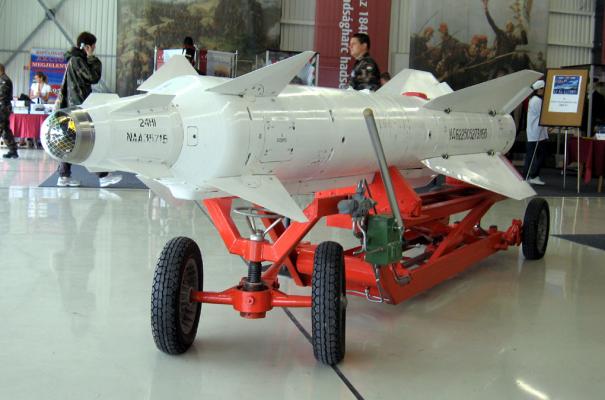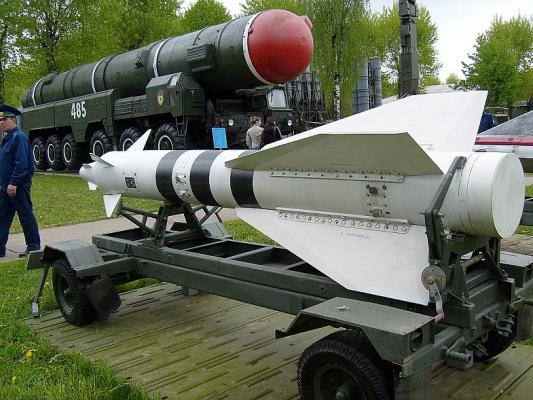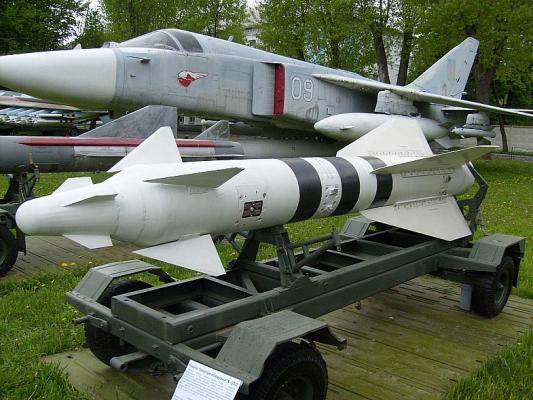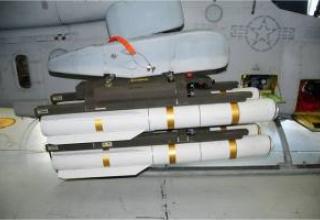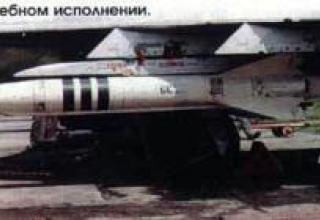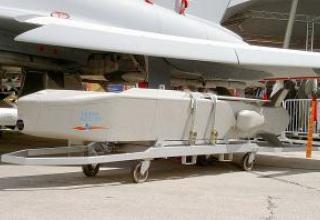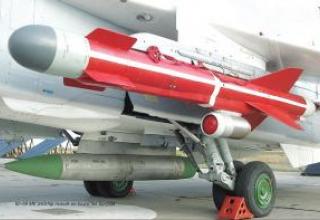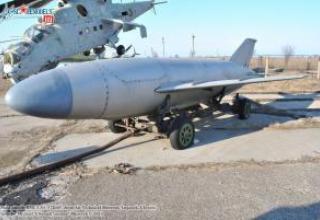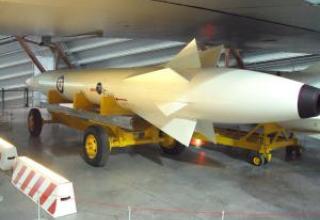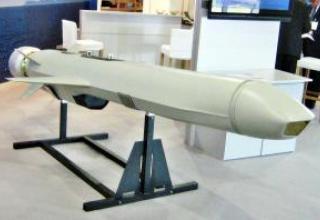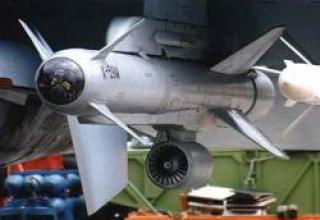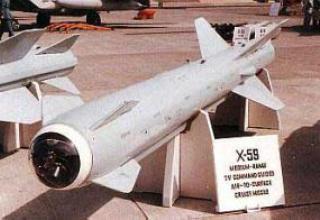X-29L rocket is designed to engage in simple weather conditions of ground targets such as: strong airplane shelters, stationary railway and highway bridges, industrial facilities, warehouses, concreted runways.
Development of the X-29 missile with a laser homing head began in the Design Bureau "Lightning" under the leadership of Chief Designer M.R. Bisnovat, later the work was transferred to the ICB "Vympel". X-29L was adopted for service in 1980. X-29L (product 64l) is equipped with the same type of GSN (24H1) as the rocket X-25ML. Unification of guidance systems has simplified the use of the missile and it was adopted for service with all types of attack aircraft. The carrier aircraft are the Su-17M2, Su-17M3, Su-17M4, Su-24M, Su-25, Su-25T, Su-34, Su-35, MiG-27K, MiG-27M, MiG-27D and MiG-29M.
Apart from X-29L, the Russian Air Force has other modifications of this missile: X-29T - with television and X-29MP - with passive homing heads. X-29 family rockets have a modular design and differ in type of installed CNS.
The X-29L rocket was supplied for export. The X-29Ls exported to Iraq were also used from the French Mirage-F.1 fighters, which have modified the system's sighting system and are equipped with the AKU-58.
In the west, the missile was designated AAS-14 "Kedge".
Composition:
The X-29L rocket is based on the aerodynamic "duck" pattern and has a modular design of five compartments - CNS, control compartment, combat unit (BC), engine and tail compartment, which can be stored in the capping separately and collected during the preparation using the flange joints (see projections).
The missile is equipped with a semi-active laser homing system - the target illuminated by the laser beam becomes a secondary "luminous" radiation source. Aiming at the target is carried out using the Proportional Approach method, which consists in pointing at the target with a preemptive so that the transverse overload of the missile is proportional to the angular speed of rotation of the sighting line, which is measured by a tracking coordinator of the CNS type 24H1.
To engage the strong and protected targets, the X-29 family missiles are equipped with a powerful 9B63MN warhead weighing 317 kg (explosive weight -116kg), enclosed in an armored penetrating hull and equipped with a contact fuse that ensures the detonation of the BC with a given deceleration after breaking through the barrier. The BC has a special anti-riot device on the front side of the hull, which increases the effectiveness of the action at small "sliding" angles of the target, frequent when launching from low altitudes and distances. The operating mode of the fuse ("instantly" or with "deceleration") is set by the pilot, and contact sensors are placed in front of the BC in the steering wheel area and run along the front edges of the wing.
A large mass required the use of a powerful power source (PAD), to improve controllability in front of the rudders installed destabilizers. The heel is controlled by ailerons on the wing. The systems and CNS are powered by an ampoule battery and an electromechanical alternating current converter with a power supply life of 40 seconds.
The control system in the vertical plane can operate in two modes.
At launches of the rocket from the carriers equipped with the illumination station type "Spotlight", in which the illumination beam is stationary relative to the longitudinal axis of the aircraft, the control system in two planes operates in homing mode. At launches from carriers, which are equipped with illumination stations such as "Maple" and "Kaira" (the illumination beam is moved relative to the axis of the aircraft), the control system of the rocket in the vertical plane allows for guidance in three stages: in the first stage on a logarithmic trajectory (autonomous guidance), in the second - the rocket turns to the target, in the third - the rocket goes to homing. This allows increasing the angle of approach to the target when launching from low altitudes. Before the target, the missile makes a "slide". The control system also stabilizes the missile on course, roll and pitch.
To ensure illumination of the target and retention on it with the necessary accuracy of the laser beam, the illumination and rangefinder station "Maple-PS", as well as two modifications of laser and TV sighting system "Kaira" and "Kaira-K" were created. Technical solutions were implemented in the designs of the illumination station and SST, excluding the influence of laser radiation from other stations of the group aircraft. The pilot's task is only to detect and mark the affected object on the TV-indicator. An automatic tracking system ensures accurate retention of the illumination beam on the target. A complex of optoelectronic devices from the illumination station and SOS provides guidance of missiles with an error of 5-7 m at the maximum range of fire.
For transportation and storage of X-29L missile a container is used.
Fazatron-NIIR Corporation OJSC proposes to install coherent ARLGSNs on X-29L and X-29T missiles weighing 15-18 kg, with the weight of the missiles being 650-680 kg and a launch range of up to 10 km.
Characteristics:
| Range of fire, km : - maximum - minimum |
8-10 2-3 |
| Fighting unit: - type - weight, kg - explosive weight, kg |
unbelievably penetrating 317-320 116 |
| Flying speed of the carrier, km/h | 600-1250 |
| Launch altitude, km | 0.2-10 |
| Dimensions, mm: - length - maximum housing diameter - wingspan - steering wheel range |
3875-3900 380-400 1100 750 |
| The homing head: - type - developer |
24H1 semi-active laser NGO "Geophysics" |
| Maximum flight speed, m/s | 600 |
| Average flight speed, m/s | 250-350 |
| Start weight, kg | 650-660 |
| Dimensions of transport container, mm: - length - width - altitude |
4500 900 860 |
| Missile weight in shipping container, kg | 1000 |
Testing:
In April 1987, in Afghanistan, the Su-25 A.Rutsky and Komeks Vysotsky, attacking carved out in the rocks near Khost warehouses, for the first time used guided missiles X-29L and X-25 with laser homing, illumination of the target for which the on-board rangefinder designator "Klen-PS" could lead and another attack aircraft, but such a technique was used infrequently for the same reason - pilots are not always able to distinguish and fix the beam low visibility objects. Thus, at the first use of the four launched X-29L in the targets, tightened with smoke, hit only two. The best results were given by the help of a ground gunner who knows the terrain well. At first, the ground laser designators tried to be mounted on APCs and BMPs improvised, then they were replaced by standard aircraft guidance combat vehicles (BOMAN) based on BTR-70, on which the system was hidden under armor and moved out while working.
The enemy quickly evaluated the importance of the unusual-looking vehicles and tried to shoot them first. After several particularly successful launches, when the missiles covered the headquarters and Islamic committees, the hunt for BOMAN began on roads and parking lots, forcing the vehicles to hide behind barbed wire and mine fences of well-guarded airfields. The rockets became a reliable weapon to destroy cave shelters, almost invulnerable to other munitions. The Mujahideen used them for storages and caches, and equipped weapons repair workshops (there was an entire cartridge factory in the cave town at the Jawara base). The mountains covered with burrows were turned into natural fortresses - dragging recoilless DShK guns and mortars upwards, dushmans arranged firing positions closed from below and artillery and tanks could not knock them out. The fire from the high rocks was extremely precise, and steep slopes and rubble did not allow to reach them. When using aircraft, the enemy was hiding in the depths under thick vaults, and bombs and ANR wastedly crushed the rocks around. After waiting for the raid, the shooters went outside and continued to fire. The accuracy of hitting the X-29L and X-25 was striking - the missiles could be placed exactly in the entrances of caves and embrasures, and their solid BC with an excess was enough to destroy the target. Heavy X-29L with BC weighing 317 kg, encased in a solid body was especially effective. Breaking through the stone, it went deep and cracked the most impregnable objects from inside. If the cave was hiding ammunition depot, the success was truly stunning.
The Su-25 rocket attack was vividly described by the commander of an airborne company pressed to the ground by fire from a dot hovering over Baglansky Gorge: "I could not lift my head when suddenly a couple of planes jumped over us, and immediately something light flew into the embrasure between the rocks and blew the dot into the crushed stone". More often than not, rather expensive rockets were used against single targets, using intelligence and carefully preparing each blow. Launches were carried out from a range of 4-5 km from a gentle dive at an angle of 25-30 degrees, the deviation of the missiles from the point of aim at this did not exceed 1.5-2 m. According to Sukhoi Design Bureau, in total, the DRA conducted 139 guided missile launches.
The calculations of combat effectiveness of the X-29L look quite convincing: Thus, a link of fighter-bombers with a full load of FAB-500 and S-25 (8t bombs and 4 missiles) was required to destroy a large target, while the same task could be solved by one Su-25 attack aircraft with a pair of X-29s; the 100m-long bridge was disabled by six aircraft with a dozen FAB-500s or just a pair of four X-29s.
Sources:
- А.В.Карпенко, С.М. Ганин "Отечественные авиационные тактические ракеты", "Бастион" N1, 2000г.
- В.Марковский. Жаркое небо Афганистана
- В.Марковский, К.Перов "Советские авиационные ракеты "воздух-земля", "М-Хобби" N1(41), 2003г
- http://photo.qip.ru/users/ostrov/95110493/98341374/
